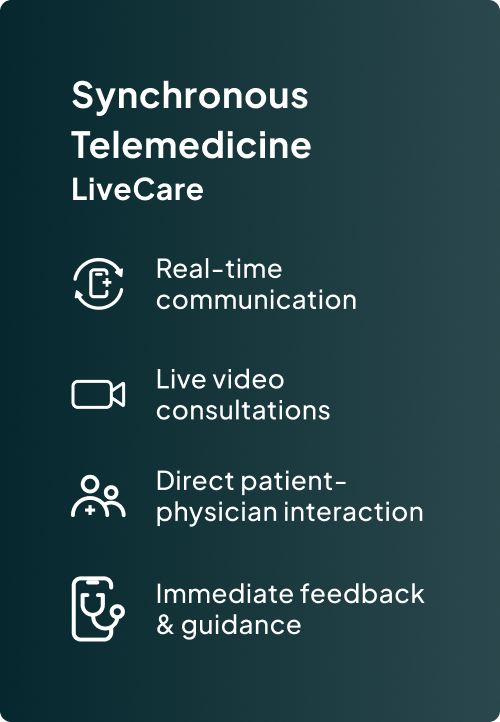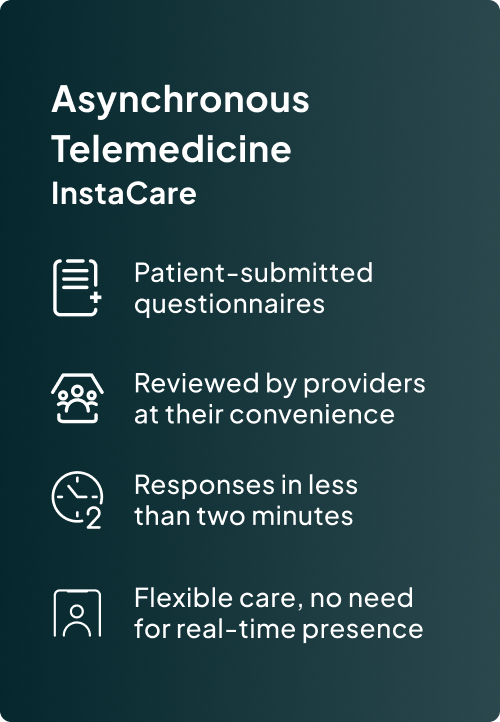
Synchronous vs Asynchronous Telehealth Services
Telehealth has revolutionized patient care and is now a permanent fixture for healthcare delivery since gaining widespread popularity in 2020. Since then, two distinct modalities of care delivery have emerged: synchronous and asynchronous care. Each form offers unique benefits and caters to different healthcare needs, reshaping the way patients and providers interact in the digital age.
Let’s dive into how these forms of telehealth are redefining healthcare delivery, their specific use cases, and their growing popularity among both providers and patients.
Understanding Synchronous Telehealth
Synchronous telehealth refers to real-time, interactive communication between a patient and a healthcare provider. This method mirrors traditional in-person consultations, leveraging technology like video conferencing, telephone calls, or live chat to facilitate immediate dialogue.
Execution of Synchronous Care
Synchronous telehealth sessions are scheduled, requiring both the patient and the provider to be present at the same time. These sessions can range from video consultations for a visual assessment to phone calls for quick check-ins or follow-ups.
Use Cases and Advantages
- Immediate Medical Attention: Ideal for urgent care or situations requiring prompt medical advice.
- Building Patient-Provider Relationships: Facilitates a personal connection, fostering trust and rapport.
- Complex Case Management: Beneficial for discussing intricate health issues that require a detailed dialogue.

Provider Perspectives on Synchronous Care
Pros:
- Immediate Feedback: Enables quick decision-making and immediate clarification of medical issues.
- Assessment of Non-Verbal Cues: Facilitates a more comprehensive understanding of the patient’s condition through visual cues, which can be crucial in diagnosis and treatment.
- Stronger Patient Relationships: Real-time interaction helps in building rapport and trust with patients, which is essential for effective healthcare delivery.
Cons:
- Scheduling Constraints: Requires coordination of schedules, which can be challenging, especially for patients in different time zones or with busy schedules.
- Technology Dependence: Relies heavily on stable internet connections and functional equipment, which can be a barrier in some cases.
- Potential for Technical Issues: Issues like poor video/audio quality can hinder effective communication.
Patient Perspectives on Synchronous Care
Pros:
- Instant Answers: Patients can get immediate responses to their health concerns, which is particularly reassuring in urgent care situations.
- Personal Connection: Direct interaction with healthcare providers can enhance comfort and confidence in the care received.
- Comprehensive Consultations: Real-time dialogue allows for a thorough discussion of health issues, including the opportunity to ask questions and receive clarifications on the spot.
Cons:
- Privacy Concerns: Some patients may feel less comfortable discussing sensitive issues via video or phone compared to in-person visits.
- Access to Technology: Requires access to appropriate technology and a stable internet connection, which might not be available to all patients.
- Limited Flexibility: Fixed appointment times can be less convenient for patients with unpredictable schedules or time constraints.

Understanding Asynchronous Telehealth
Asynchronous telehealth involves the transmission of patient health information to a healthcare provider at a different time. This modality includes sending images, messages, intake forms or other types of health data for later review.
How Asynchronous Care Works
Patients can submit their queries, symptoms, or medical data via secure platforms at their convenience. Healthcare providers then review this information and respond with a diagnosis, treatment plan, or further inquiries, all on a flexible timeline.
Use Cases and Benefits
- Routine Health Management: Effective for treating acute conditions or regular follow-ups for chronic disease management.
- Flexibility and Accessibility: Ideal for patients with busy schedules or those in remote areas.
- Efficient Resource Utilization: Allows providers to manage their time and caseloads more effectively.
Provider Perspectives on Asynchronous Care
Pros:
- Efficient Time Management: Allows providers to review patient information and respond at their convenience, leading to better time utilization.
- Broader Patient Reach: Enables care for a larger patient base, as providers can manage more cases asynchronously.
- Detailed Information Review: Providers can take time to analyze patient-submitted data thoroughly, which can aid in accurate diagnosis and treatment planning.
Cons:
- Delayed Response Time: The time gap between patient queries and responses might not be suitable for urgent care needs.
- Limited Personal Interaction: Lack of real-time interaction can sometimes hinder the development of a strong patient-provider relationship.
- Dependence on Patient Inputs: The effectiveness of care largely depends on the accuracy and completeness of information provided by patients.
Patient Perspectives on Asynchronous Care
Pros:
- Convenience and Accessibility: Patients can communicate their health concerns at any time, making healthcare more accessible, especially for those with busy schedules or living in remote areas.
- Privacy and Comfort: Some patients may feel more comfortable sharing sensitive information through messages rather than face-to-face.
- No Need for Immediate Availability: Eliminates the need to align schedules for a live consultation, offering greater flexibility.
Cons:
- Lack of Immediate Feedback: Patients may have to wait for responses, which can be a concern in situations where quick answers are needed.
- Potential for Miscommunication: Without real-time interaction, there’s a risk of misinterpretation of written communication or insufficient detail in patient descriptions.
- Technology Literacy: Requires a certain level of comfort with digital tools and platforms, which might be a barrier for some patients.
Synchronous vs Asynchronous: Complementary Forces in Telehealth

While synchronous and asynchronous telehealth differ in execution and application, they are not mutually exclusive. In fact, they often complement each other, providing a comprehensive telehealth experience. For instance, a patient might use asynchronous methods for routine updates and switch to synchronous interactions for more complex issues.
The Future of Telehealth: A Blend of Synchronous and Asynchronous Care
The future of telehealth lies in the integration of both synchronous and asynchronous methods, offering a hybrid model that caters to diverse patient needs and preferences. This blend ensures that healthcare is not only accessible and efficient but also personal and comprehensive.
Embrace the Full Potential of Telehealth with WellSync
WellSync stands at the forefront of this telehealth evolution, offering solutions that encompass both synchronous (LiveCare) and asynchronous (InstaCare) options. By partnering with WellSync, healthcare providers can offer a more dynamic, flexible, and patient-centered approach to care, ensuring they meet the diverse needs of their patient population effectively and efficiently.


